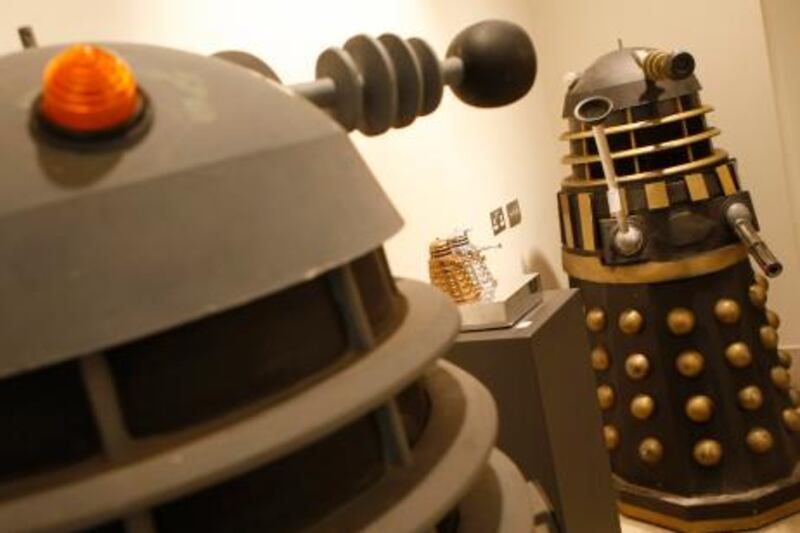"There's a problem with the Daleks," said Steven Moffat, the executive producer of the BBC show Doctor Who, on which the diabolical cyborgs appear. And he wasn't referring to their shrill voices, limited vocabulary or difficulty going up stairs. "They are the most famous of the Doctor's adversaries and the most frequent, which means they are the most reliably defeatable enemies in the universe," he said.
Moffatt then joked that the legendary Time Lord has triumphed over the pepper pot-shaped aliens "about 400 times", before telling the Radio Times that he plans to "give them a rest".
Considered the quintessential Whovian baddies, they first yelled "Exterminate!" in the opening series of the show, which began in 1963, and were last seen in the 2010 episode The Pandorica Opens, conspiring with several other long-time villains to trap the pesky Doctor (played by Matt Smith) in an impenetrable box underneath Stonehenge.
In the show, the tanklike machines contain living mutant aliens and were created by the scientist Davros on the planet Sarko, during a thousand-year war against the Thals. Genetically engineered without pity, compassion or remorse and bent on genocide, they made their first appearance less than two decades after the end of the Second World War, and their creator, Terry Nation, is said to have based them on the Nazis.
Also during the 1960s, but on the other side of the Atlantic, another alien adversary made its first appearance. Although Klingons are known for their bumpy foreheads, in the original series of Star Trek the warrior race had no more ridges on their craniums than their human counterparts. Instead (due to tight make-up budgets), they sported just bronze skin and prominent facial hair.
It's been said that the original Klingons were intended to call to mind America's Second World War adversary, Japan. The honourable, yet rather brutal aliens found a rather more long-lasting allegorical role as the Soviet Union in opposition to the United States's future counterpart in the show, the United Federation of Planets. The theory is reinforced by the fact that Klingons and the Federation finally made peace in the 1991 movie Star Trek VI: The Undiscovered Country, less than two years after the fall of the Berlin Wall.
While using men in rubber suits and make-up as an allegory for the "Communist threat" that began in 1950s cinema with films such as The Thing From Another World, sci-fi writers also used stories of alien adversaries to comment on the culture of suspicion in the US during the Cold War. The 1956 classic Invasion of the Body Snatchers depicted a small American town gripped by an epidemic of mass hysteria, as members of their community are replaced by the Pod People. The film is considered by many to be a covert indictment of McCarthyism and the heightened fears of Communist influence during the era.
By the 1970s and 1980s, onscreen alien races had become much more... alien. The trophy-hunting warriors of Predator and the Xenomorphs from Alien were both stronger than humans, didn't speak our languages, and made it clear that we were no longer at the top of the food chain, (even if they were still played by men in rubber suits).
These fictional races spawned successful franchises because they played on innate human fears such as infection and being hunted.
Many of the most villainous races in science fiction were simply intended to reflect the worst characteristics of mankind. The Harkonnens of Frank Herbert's classic novel Dune are wasteful and greedy people, who use political and military force to exploit other planets when their homeworld is exhausted of resources. The slug-like Vogons of Douglas Adams's The Hitchhiker's Guide to the Galaxy are mocked for their obsessively bureaucratic nature, as well as for producing the third worst poetry in the universe. Meanwhile, The Galactic Empire of the Star Wars universe - a giant military force ruled by a secretive individual - has been compared to the Third Reich and the US military-industrial complex.
In some sci-fi, depicting man's shortcomings requires few allegories. Avatar saw mankind becoming the alien invader, as soldiers and corporate stooges fight to steal the resources of the peaceful indigenous Na'vi. In The Day the Earth Stood Still, humanity is ordered to end all war or face extinction by an advanced civilisation.
Greed, shortsightedness and dependence on technology is usually depicted more allegorically, however. The Terminator movie franchise and Battlestar Galactica series both feature man's mechanical creations turning against their masters and threatening them with extermination.
If there is to be a consensus drawn from science fiction, it might well be that, if any of the galaxy's species need to be "given a rest" - it's us.
Follow us on Twitter and keep up to date with the latest in arts and lifestyle news at twitter.com/LifeNationalUAE





